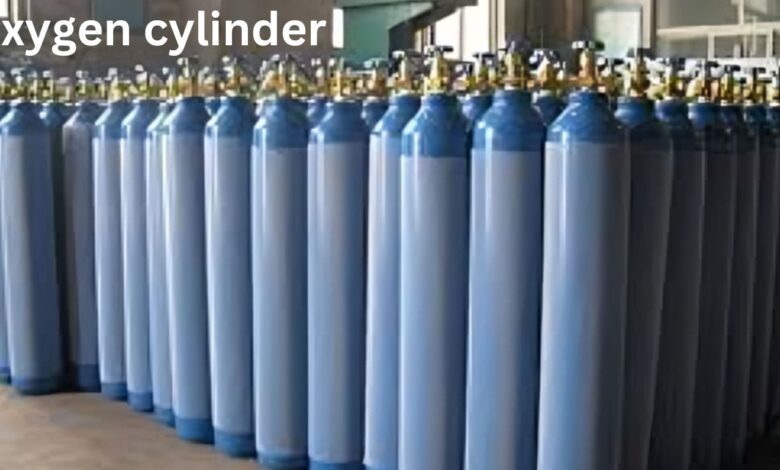Comprehensive Guide to Oxygen Cylinders Everything You Need to Know

Oxygen cylinders play a vital role in providing medical support, ensuring patients and individuals with breathing difficulties receive the oxygen they need. Whether in hospitals, at home, or during emergencies, have become a critical part of healthcare and life support systems. This article provides an in-depth overview of covering their types, uses, safety measures, and tips for choosing the right one.
What is an Oxygen Cylinder?
An Oxygen Cylinders is a storage container filled with compressed oxygen gas, designed for medical, industrial, or personal use. It serves as a portable source of oxygen for individuals who have difficulty breathing due to medical conditions such as chronic obstructive pulmonary disease (COPD), asthma, or COVID-19. These cylinders are also commonly used in high-altitude environments, underwater diving, and various industrial applications.
Types of Oxygen Cylinders
Oxygen cylinders come in various types and sizes to suit different needs. Below are the primary types:
1. Compressed Oxygen Cylinders
Compressed store oxygen in a high-pressure state. These are the most common types used in medical settings. The oxygen is released through a regulator that controls the flow rate. They are typically made of aluminum or steel and come in a variety of sizes, making them suitable for both portable and stationary use.
2. Liquid Oxygen Cylinders
Liquid store oxygen in its liquid state at extremely low temperatures. These cylinders are more compact and can hold a larger amount of oxygen compared to compressed cylinders. They are often used in home healthcare settings due to their lightweight and ease of use.
3. Portable Oxygen Cylinders
Portable are lightweight and designed for mobility. They are ideal for individuals who need oxygen therapy while on the go. These cylinders are often used in combination with portable oxygen concentrators for added convenience.
4. Industrial Oxygen Cylinders
Industrial cylinders are used in welding, cutting, and other manufacturing processes. These cylinders contain oxygen at a much higher pressure and are not intended for medical use.
Common Uses of Oxygen Cylinders
Oxygen cylinders are indispensable in various fields, including healthcare, aviation, and underwater exploration. Here are some of their most common applications:
1. Medical Use
Medical are widely used in hospitals, clinics, and home care settings. They provide supplemental oxygen to patients with respiratory issues, including those suffering from:
- COPD
- Pneumonia
- COVID-19
- Asthma
- Sleep apnea
Oxygen therapy is also administered to improve oxygen saturation levels during surgical procedures and critical care situations.
2. Emergency Use
Oxygen cylinders are a crucial part of emergency response kits. They are used by paramedics and first responders to provide immediate relief to individuals experiencing respiratory distress or cardiac arrest.
3. High-Altitude and Aviation Use
In high-altitude environments, the oxygen concentration in the air is lower, which can lead to altitude sickness. cylinders are used to supply supplemental oxygen to climbers, hikers, and aviators.
4. Underwater Diving
Scuba divers rely on to breathe underwater. These cylinders are specifically designed to withstand high pressure and provide a reliable source of oxygen during dives.
5. Industrial Use
In industrial settings, oxygen cylinders are used for welding, cutting, and other processes requiring high temperatures. The pure oxygen helps achieve efficient combustion and precise operations.
Choosing the Right Oxygen Cylinder
Selecting the appropriate oxygen cylinder depends on several factors, including the intended use, portability, and capacity requirements. Here are some key considerations:
1. Size and Capacity
Oxygen cylinders come in different sizes, ranging from small portable options to large stationary units. For home use or mobility, a lightweight, portable cylinder is ideal. For hospital or industrial use, larger cylinders with higher capacity are preferable.
2. Flow Rate
The flow rate determines how much oxygen is delivered per minute. Patients requiring oxygen therapy should consult a healthcare professional to determine the appropriate flow rate and cylinder type.
3. Material
Oxygen cylinders are typically made of steel or aluminum. Aluminum cylinders are lightweight and corrosion-resistant, making them suitable for portable use. Steel cylinders are more durable and ideal for stationary setups.
4. Accessories
Essential accessories include:
- Regulators: Control the flow of oxygen.
- Cannulas or Masks: Deliver oxygen to the user.
- Carrying Cases or Trolleys: Enhance portability and ease of handling.
5. Certification
Ensure the oxygen cylinder is certified and meets safety standards. Look for markings indicating compliance with ISO, CE, or other regulatory bodies.
Safety Tips for Using Oxygen Cylinders
Oxygen is a highly flammable gas, and improper handling can lead to accidents. Follow these safety tips to ensure safe use:
1. Store Properly
- Keep cylinders in a cool, dry place away from direct sunlight or heat sources.
- Store cylinders upright and secure them with straps or brackets to prevent tipping.
2. Avoid Contamination
- Never allow oil, grease, or flammable substances near the cylinder.
- Ensure hands are clean and dry before handling.
3. Handle with Care
- Avoid dropping or striking the cylinder.
- Use proper tools when opening or closing the valve.
4. Monitor Oxygen Levels
- Check the pressure gauge regularly to ensure the cylinder has sufficient oxygen.
- Refill or replace the cylinder before it runs out.
5. Follow Manufacturer’s Instructions
- Adhere to the manufacturer’s guidelines for usage, storage, and maintenance.
- Regularly inspect the cylinder and its accessories for signs of wear or damage.
Environmental Impact and Recycling
Oxygen cylinders, like any other equipment, have an environmental impact. Proper disposal and recycling of cylinders are crucial to minimizing waste and conserving resources. Contact local recycling facilities or manufacturers to learn about recycling options for empty or expired cylinders.
The Future of Oxygen Therapy
Advancements in technology are paving the way for innovative solutions in oxygen therapy. Portable oxygen concentrators are becoming more efficient, offering an alternative to traditional cylinders. These devices generate oxygen on demand and eliminate the need for refills, making them more convenient and environmentally friendly.
Additionally, research is ongoing to develop lightweight, high-capacity cylinders that are easier to transport and store. Such innovations will further enhance the quality of life for individuals requiring oxygen therapy.
Conclusion
Oxygen cylinders are a critical resource in healthcare, emergency response, and various industrial applications. Understanding their types, uses, and safety measures is essential for maximizing their benefits and ensuring safe usage. Whether you’re a medical professional, caregiver, or individual in need of oxygen therapy, selecting the right cylinder and adhering to safety protocols can make a significant difference in its effectiveness and usability.
With the growing demand for oxygen therapy and technological advancements,s will continue to play a pivotal role in improving lives and supporting medical care. Always consult a healthcare professional for personalized advice and guidance on oxygen therapy and equipment selection.



